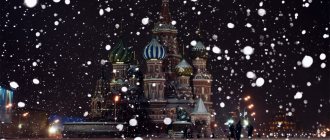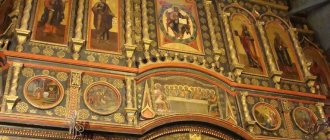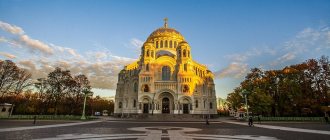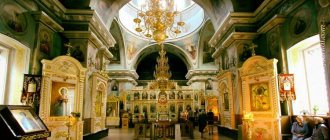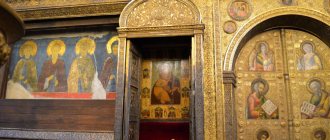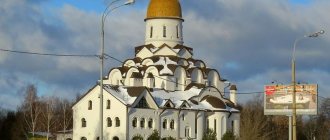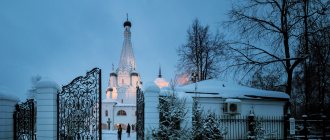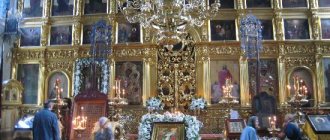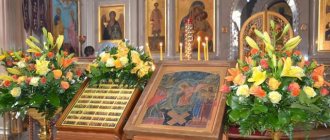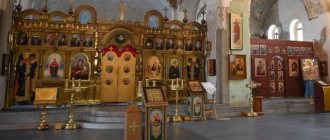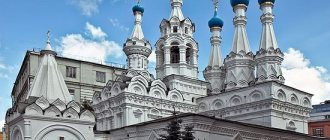What is the name of the cathedral?
Take, for example, the name of the cathedral. People call it the Temple or St. Basil's Cathedral. There is no terrible mistake in this. But few people know that its first and main name is the Cathedral of the Intercession of the Blessed Virgin Mary “on the Moat.” St. Basil's Cathedral is, rather, the “folk” name assigned to it.
Internal gallery around the Church of the Intercession of the Blessed Virgin Mary
The Intercession Cathedral was erected according to the vow of Ivan the Terrible, which he made before the campaign against Kazan in 1552, and with the blessing of Metropolitan Macarius. The conquest of the Kazan Khanate was the most important event in the history of Russia, and this significance was emphasized by the construction of a grandiose cathedral.
Another misconception is that a cathedral is only one temple. They call it St. Basil's Cathedral, period. In fact, in 1555–1561, nine churches were erected on a single foundation (basement), five of which were then consecrated in memory of the Kazan campaign. According to historical documents, the main part of the cathedral was erected in the autumn of 1559. At the same time, the consecration of all its churches, except for the central one, took place. And only a year and a half later, on June 29 according to the old calendar, the entire cathedral was consecrated. This day is considered the date of completion of the temple.
Reliquary with the relics of St. Basil
In the center of the cathedral is the main temple - the actual Church of the Intercession of the Blessed Virgin Mary, crowned with a small onion dome. On October 1, 1552, the assault on Kazan began - at the same time, according to the church calendar, the Feast of the Intercession of the Virgin Mary was celebrated. Therefore, the central temple was named in honor of this holiday, and then the entire cathedral was named after it. By the way, the Intercession Cathedral was at that time the tallest building in Moscow. Before the reconstruction of the Ivan the Great Bell Tower in the Kremlin at the end of the 16th - beginning of the 17th centuries, it was the high-rise dominant feature of the then Moscow.
In total, the cathedral has eleven domes. Ten are the domes of the churches according to the number of thrones, and there is another dome above the bell tower. The complex architectural composition and construction program of the cathedral most likely belonged to Metropolitan Macarius, who wanted to embody the image of the Heavenly City of Jerusalem on earth in the multi-altar church, as well as to exalt the role of Moscow and Ivan the Terrible.
Eight churches are located symmetrically around the main temple in the form of an eight-pointed star. Four large churches face strictly to the cardinal directions.
Church of Cyprian and Justina
The memory of the saints falls on the second of October (October 15, New Art.), and it was on this day that Kazan was taken.
Church of Gregory of Armenia
Gregory of Armenia - educator of Great Armenia. His memory is celebrated on September 30 (October 13 N.S.). In 1552, on this day, an important event in the campaign of Tsar Ivan the Terrible took place - the explosion of the Arsk Tower of Kazan.
Church of the Entry of the Lord into Jerusalem
The church was consecrated in honor of the Feast of the Entry of the Lord into Jerusalem. On Palm Sunday, it was to this chapel that the procession of the cross from the Assumption Cathedral of the Kremlin took place with the “procession on the donkey” of the Patriarch. That's why the chapel was built on the side closest to the Kremlin.
Church of Varlaam Khutynsky
Consecrated in the name of St. Varlaam of Khutyn, Novgorod saint, founder and abbot of the Spaso-Preobrazhensky Khutyn Monastery.
Church of St. Nicholas Velikoretsky
This church was consecrated in the name of the Velikoretsky image of St. Nicholas the Wonderworker. The icon of the saint was found in the city of Khlynov on the Velikaya River, which is why it later received the name “Nikola Velikoretsky”. In 1555, by order of Ivan the Terrible, this icon was brought in a religious procession along the rivers from Vyatka to Moscow.
Church of Alexander Svirsky
It is consecrated in the name of this saint, because his memory is celebrated on the same day on which the defeat of the Epancha cavalry took place on the Arsk field.
Bell tower
Church of the Three Patriarchs (John, Alexander and New Paul)
It was named so because in 1552, on the day of remembrance of the patriarchs, August 30 (September 12, n.st.), a victory was won over Prince Epancha, who came from Crimea to the aid of the Kazan Tatars.
Holy Trinity Church
It is generally accepted that the Intercession Cathedral was built on the site of the ancient Trinity Church, by the name of which the entire temple was often called until the 17th century.
St. Basil's Church
The only temple where regular services are held today.
Church of the Intercession of the Blessed Virgin Mary
It was on the first of October 1552, on the feast of the Intercession of the Virgin Mary, that the assault on Kazan began.
Where did the name "St. Basil's Cathedral" come from?
But why did they begin to call the Intercession Cathedral the Cathedral of St. Basil the Blessed and associate it not with Ivan the Terrible and the Kazan campaign, but with the name of the holy fool? The fact is that in 1588 a chapel was added to the cathedral on the north-eastern side, consecrated in honor of St. Basil. It was built by order of the son of Ivan the Terrible, Fyodor Ioannovich, over the burial place of St. Basil the Blessed, who died in 1557 and was buried near the walls of the cathedral under construction. The famous holy fool himself became famous in Moscow somewhere at the end of the fifteenth century. All his clothes, winter and summer, consisted only of iron chains. Muscovites loved Vasily very much for his gentle disposition, including the young Tsar, although the holy fool was sometimes not afraid to contradict him and reproach him. Under Fyodor Ioannovich, St. Basil's canonization took place in 1586.
Fragment of the decor of the cathedral
With the addition of St. Basil's Church, services in the cathedral became daily. Since then, the Intercession Cathedral has been known more as St. Basil's Cathedral. Previously, services were held there only in the warm season. The cathedral was not heated, but St. Basil's Cathedral was warm. In addition, since the cathedral was built as a memorial, it was very difficult to hold services in its churches due to their small size. Only the royal family could fit in. Soon the popular name for the cathedral arose - St. Basil's Cathedral.
Church of the Intercession of the Blessed Virgin Mary in Fili
| Church of the Intercession in Fili |
The famous Church of the Intercession in Fili, stunning in its beauty, has only recently returned to church life.
Erected during the time of Peter I, it became a real symbol of Russian history and Moscow culture. However, even today it is going through difficult times, remaining a half-closed temple. "Pokrovskoe, Fili also"
The history of Fili goes back to very ancient times. It is traditionally believed that the name of the area comes from the small river Khvilki, in common parlance Filki, the right tributary of the Moscow River. According to the dictionary of V.I. Dalya “khvilya” means “wet”, “bad weather”, “slurry” - that is, a damp, unhealthy (“frail”) swampy area. Another version is more complicated: the toponym Fili comes from the Finno-Ugric “vele” - “settlement” and goes back to those distant pre-Moscow times when Finno-Ugric pagan tribes lived here.
The reliably known history of Fili began in the 16th century, when Grand Duke Vasily III granted local lands as an patrimony to his boyar Fyodor Mikhailovich Mstislavsky, who arrived in Russian service from Lithuania. His son Ivan Mstislavsky held the estate under Ivan Vasilyevich the Terrible, for he was the first commander in the campaign against Kazan, but under Boris Godunov he was unlucky: Ivan Mstislavsky and his daughter Irina participated in a boyar conspiracy against Godunov and after his accession they found themselves in disgrace. Mstislavsky was exiled to the Kirillo-Belozersky Monastery, where he stayed until his death, and Irina was tonsured as a nun at the Moscow Ascension Monastery in the Kremlin.
However, the Filevo patrimony did not leave the Mstislavsky family ownership and was transferred to the son of Ivan Mstislavsky - Fedor, who was destined to appear more than once on the pages of Russian history. He was the great-grandson of Vasily III - it so happened that since ancient times Fili belonged to relatives of the ruling dynasties. Therefore, Fyodor Mstislavsky even laid claim to the Russian throne, competing with Godunov and the Romanovs. Usually Godunov did not forgive this, but, nevertheless, under him Fyodor Mstislavsky headed the Boyar Duma, went out with an army against False Dmitry I, and after the fall of Tsar Vasily Shuisky, in 1610–1612, in the “sovereignless time,” it was he who headed the boyar a government of seven noble boyars, that is, he was the head of the famous Seven Boyars. And then he successfully entered the circle of the first Romanov.
At the time when Fyodor Mstislavsky owned the Filevo estate, a wooden Church of the Intercession with a chapel in honor of the Conception of St. Anna of the Blessed Virgin Mary appeared here. The temple was founded in 1619 not only by the Mstislavskys, but also by the efforts of the recently reigned Mikhail Fedorovich in honor of a memorable and beneficial event for Moscow and Russia: on the Feast of the Intercession, October 1, 1618, the troops of the Polish prince Vladislav, called up to the Russian throne during the Time of Troubles, and the Polish Hetman Sagaidachny, who tried to take Moscow by storm, were decisively repulsed by the Russians. This was the actual end of the Time of Troubles. In this victory, Muscovites saw the clear patronage of the Mother of God, and then several new Intercession churches appeared in Moscow (in the royal residences of Rubtsov and Izmailovo and in Medvedkovo - the estate of Prince Pozharsky), including in Fili. And although the temple was built with the care of the first Romanov, the Mstislavskys equipped the temple, providing it with icons, utensils and bells.
The appearance of the Conception chapel was due to the fact that Fyodor Mstislavsky remained childless - all his children died in infancy, and he passionately wanted to have an heir and built this chapel in prayer. And yet he was left without offspring. After his death in 1622, the Filevo patrimony passed to his sister Irina, a nun of the Ascension Monastery. Since she did not leave the monastery, all affairs on the estate were managed by the manager Tretyak Rezantsev. In the wooden Church of the Intercession, an icon of the martyr Irina was kept in honor of the owner’s name day. Only after the death of the nun, which followed in 1639, was the estate taken into the treasury, and a palace economy was established in it. And the clergy in the Intercession Church was appointed by the patriarch himself in view of the palace status of Fili.
Tsar Alexei Mikhailovich treated his distant patrimony with care, for he loved to “amuse himself” here, that is, to hunt birds and all kinds of animals, ordering them to take care of the “Khvilsky swamps” and not let anyone there. Already in 1646, Alexei Mikhailovich granted this property to Ivan Danilovich Miloslavsky, the father of his first wife Maria Ilyinichna. Everyone remembered the past poverty of the Miloslavskys, when his daughters sold mushrooms they had collected in the forest with their own hands at the market, but he skillfully used his new position at court and, after the salt riot of 1648, headed the government. He clearly failed in government: during the next copper riot of 1662, Miloslavsky was accused of treason by the rebel Muscovites. However, he lived safely until his death in 1668, and the following year his crowned daughter also died. The Filevskoe estate passed to the nephew of the late queen, the famous Ivan Mikhailovich Miloslavsky, the future instigator of the Streltsy riot of 1682 and the head of anti-Naryshkin sentiments. In his last years, the disgraced boyar lived out his other estate, Vsekhsvyatskaya, on Sokol, but only after his death in 1685 did the Filevo lands again go to the treasury.
By that time, dramatic events had already unfolded in Moscow, affecting the fate of Fili and the local Church of the Intercession. In May 1682, at the instigation of the Miloslavskys, a Streltsy revolt broke out against the Naryshkins: two boyar clans, related to the two wives of Alexei Mikhailovich, fought for power and influence on the throne, deciding who would rule - Ivan Alekseevich, the heir from the tsar’s first wife, or Peter, son of Naryshkina.
On April 27, 1682, 21-year-old Tsar Fyodor Alekseevich, son of Alexei Mikhailovich and Maria Miloslavskaya, suddenly died. Rumors immediately spread throughout Moscow that the Naryshkins had harassed the sovereign in order to gain power. These rumors were especially aggravated by the strange circumstance that on the very day of the tsar’s death, the Naryshkin brothers, including Lev Kirillovich, were granted sleeping quarters, that is, they received close access to the sovereign. All this excited the people and the Streltsy army. And already on May 15, a new rumor was launched that the Naryshkins strangled Tsarevich Ivan Alekseevich so that the throne would finally go to Peter. And then Tsarina Natalya Kirillovna came out to the worried archers on the Red Porch along with the young princes Peter and Ivan. The Streltsy were confused, but still demanded that the “traitors” Naryshkins be handed over. One boyar angrily shouted at them to disperse, and they rebelled.
Two brothers of Tsarina Natalia Kirillovna were killed by archers, and the third, Lev Kirillovich, who was only 14 years old at the time, hid in the women's half of the palace, almost in a closet. According to legend, an icon of the Savior Not Made by Hands hung above the door of this closet. According to another version, the youth locked himself in some room where there was an icon of the Savior Not Made by Hands; falling to his knees, he prayed to the Lord to save his life and made a vow: if he remained alive, he would build a temple in honor of this icon.
Lev Naryshkin survived and began to gradually ascend to the ranks of Peter's associates: already in 1688, the 20-year-old youth was granted a boyar status. In June 1689, Peter gave him the Filevo estate with villages, and after the final victory over Sophia, won in August of the same year, he appointed him head of the Ambassadorial Prikaz. The boyar immediately began to fulfill his vow, and soon a new church appeared in Fili...
"The Church is heaven on earth"
This stone church became the home temple of Lev Naryshkin in the Filevo estate, where he built one of the first estates in Russia in the European “regular” manner: with a park, ponds, an orchard and a palace with a tower topped with a clock. He made himself an exclusively country residence, and resettled the local peasants 1.5 km from the temple on the Bolshaya Mozhaisk Road and created the new village of Fili - it was there that the famous “Kutuzov hut” later ended up. In the Fili estate, only the courtyard people remained. After the construction of the new church, the residence began to be called the village of Pokrovsky, sometimes with the addition of “Fili also.”
The new church became the crossroads of Russia and Europe, “a bridge between the Moscow of Tsar Alexei Mikhailovich and the Northern Palmyra of Emperor Peter the Great,” as one modern researcher aptly put it. It is textbook known that it became a classic example of Naryshkin baroque: the name was given because it was Lev Naryshkin who built his house churches in Moscow in this style, although many, many imitated him. Using the example of the Church of the Intercession, since it is accessible to visitors, one can become familiar with this style in its entirety.
In 1712, shortly after the construction of the church, a fire in the Moscow house of the Naryshkins destroyed the entire archive. The names of the craftsmen who built this church, the author of the plan, the model that became the prototype remained unknown, and one can only guess about the time of its construction. It was definitely built between 1689, when Lev Naryshkin was granted the Filevo estate, and 1694, judging by the date carved on the church lamp. The main difficulty is the name of the architect. Scientists have three versions on this matter: an unknown architect, Ukrainian masters, Yakov Bukhvostov. Or Peter I provided craftsmen from the Order of Stone Affairs and the Armory, which could have happened in any case. There are two known masters who participated in the decoration of the church and painting - Karp Zolotarev and Kirill Ulanov. The influence of Ukraine, which was annexed to Russia in the same century, and the influence of Poland, exerted through the same Ukraine, are undeniable. In 1681, Tsar Fyodor Alekseevich sent Karp Zolotarev to Little Russia to study local architecture and measure churches. The Emperor then planned to build a luxurious Church of the Resurrection on Presnya, but his death cut short these plans, and work in Ukraine was useful to Karp in the future.
Foreign masters who worked at the royal court were required to have Russian students. Karp Zolotarev was a student of the painter Bogdan Saltanov, an Armenian from Persia who painted icons in the European style. Karp himself previously worked in the New Jerusalem Monastery, then participated in the creation of iconostases in Novodevichy, he also worked for Golitsyn in the Armory Chamber, and then in the Ambassadorial Prikaz. After 1689, for his closeness to the disgraced Golitsyn, Karp was fired from the Ambassadorial Prikaz, but was quickly returned - the master was too good at mastering the new art needed by Peter I and his new era. And in 1690, the Ambassadorial Prikaz was headed by Lev Naryshkin - and immediately invited the master to his Fili, where he performed the iconostasis and several images.
The Church of the Intercession in Fili has two main common features. Firstly, this is a house church, that is, intended exclusively for the owners of the residence and their guests. Hence its small capacity - inside it is incomparably smaller than outside. Secondly, the house church at the same time was intended to symbolize the power, status, wealth, merit, origin and position of its owners, especially the closest relatives of the ruling sovereign. It is reliably known that Tsarina Natalya Kirillovna donated money for the construction of the Filevo temple, and also gave a towel, according to legend, embroidered by her hands, and Peter himself released 400 gold chervonets from the treasury. He generally loved the estates of his relatives, and Fili especially; besides, the owner was his age, for he was only four years older than the royal nephew.
| Church plan. Photo from the site cultinfo.ru |
The original structure of the church corresponded to both the general plan and the vow of Lev Naryshkin.
It has two altars: the lower tier is occupied by a winter heated church in honor of the Intercession of the Virgin Mary, in memory of the old wooden church of Fili, and in the upper tier there is the main church in honor of the Savior Not Made by Hands. Contrary to canonical tradition, the altars are located exactly above each other: the lower altar does not protrude to the east, as was customary, in order to avoid stepping over the holy altar. The white-stone staircase-galleries leading to the upper church seem to prepare the pilgrim’s meeting with God, with a miracle. The traditional five-domed structure - a symbol of the Savior surrounded by the apostles-evangelists - was also originally designed in a temple built “like bells,” when the church was also a belfry: four side domes were attached to the body of the temple and oriented to the cardinal points, and the central dome was located far from them and ascends upward. To commemorate the relationship of the owner with the royal dynasty and the participation of the sovereign himself in the construction of the temple, the eastern and western chapters under the crosses were crowned with double-headed eagles, and the central chapter was also crowned. Inside there is a separate box for the owner and his guests, nicknamed the “royal” one: a narrow balcony seems to hang in the air in front of the iconostasis on the western wall - in the place where the choirs for the grand-ducal family were located in ancient Russian churches. (The legend says, however, that when visiting the Filevsky temple, Peter I never went up to the royal box, remaining during the service on the choir with the singers, and he himself, as was his custom, sang with them.) And the white-foam, carved stone decor with cockscombs also testified to the status and wealth of the owners, because only very rich customers could afford such luxury. The interior of an Orthodox church symbolizes the heavenly world: “The Church is the earthly heaven, and the heavenly God dwells in it.” The Church of the Intercession is no less original inside than outside, and echoes the main idea. Her temple icon, placed in the local rank of the iconostasis, was the same Kremlin image of the Savior Not Made by Hands, in front of which young Naryshkin prayed for salvation. And, fulfilling his vow, he honored the image, which became the main shrine of the temple. They ordered a huge wooden frame for it with stamps, in which they placed picturesque scenes telling the history of the image from “The Tale of the Savior Not Made by Hands” by John of Damascus. And the image itself was placed in a silver frame, richly decorated with precious stones. (Now there was only one frame left, and judging by it, the image itself was quite small.)
The main attraction of the temple was the carved iconostasis. In this church, according to the fashion established at the court of Princess Sophia, there was no wall painting, and its absence was “compensated” by the beauty of the unique nine-tiered iconostasis. Its nine tiers are probably associated with the Feast of the Intercession, patronal for the former Filevo church and for the lower church, and symbolize the image of the Most Holy Theotokos as the Queen of the Heavenly Church, consisting of nine ranks of angels and nine ranks of righteous people. To the left of the royal doors is an image of the Dormition of the Mother of God, executed by icon painter Kirill Ulanov as a paired icon of the Savior Not Made by Hands, in the same wooden frame with stamps on scenes from the “Tale of the Dormition” attributed to John the Theologian. However, new trends are evident with a deviation from canonical traditions: at the top it is not the ascension of the Mother of God, but Her coronation as the Queen of Heaven. The Ascension is depicted in one of the marks, and, according to scientists, according to the Dutch model - as an ascension
to heaven.
Otherwise, the lower tier of the iconostasis consists entirely of icons according to the names of the owners of the house and their august relatives. The image “Apostles Peter and Paul” is dedicated to the name day of Peter I, “John the Baptist and Alexy, the man of God” - the name day of his co-ruler Ivan Alekseevich (or, according to another version, the owner’s brother, Ivan Naryshkin, killed by archers) and Tsar Alexei Mikhailovich. The icon of the martyrs Adrian and Natalia was built in honor of the namesake of Tsarina Natalya Kirillovna, and the image of St. Leo, Bishop of Catania, and the Great Martyr Paraskeva - in honor of the name day of Lev Naryshkin himself and his first wife Praskovya.
It is interesting that in this church, quite unexpectedly, the ancient canonical tradition is observed - to depict on the deacon doors the holy deacons - martyrs of the ancient Christian Church: on the northern door there is an image of the first martyr Stephen, the first of the seven deacons appointed by the apostles, and the first Christian saint, and on the southern door there is an image Roman archdeacon Lawrence, who suffered in the 3rd century. Later, the heavenly goalkeepers - the archangels Michael and Gabriel - were usually depicted on the deacon's doors.
However, the ancient church canon is observed in a rather unique way: in the face of St. Stephen, the young Peter I is easily discernible, and in St. Lawrence, scientists see a portrait of his co-ruler Ivan. The ancient tradition received another meaning here: the feasts of Saints Stephen (August 2) and Lawrence (August 10) coincided with a particularly memorable date: it was on these August days of 1689 that Peter I not only saved himself from Princess Sophia, but also finally defeated her . In addition, in the image of the Apostle Peter, letters from Karp Zolotarev, they see the first self-portrait image in Russia, in which they see the influence of the Western tradition. According to priest Boris Mikhailov, rector of the Church of the Intercession and candidate of art history, the creation of this image was greatly influenced by the painting “Apostles Peter and Paul” by El Greco, painted in 1614. The apostles are depicted with symbols of their suffering: the Apostle Peter holds a cross, and the Apostle Paul holds a sword.
The structure of the temple influenced the width of the iconostasis - it is quite narrow and there are fewer images in ranks than usual. In the Deesis rite, instead of the traditional “Savior in Power”, the image of “Tsar by Tsar” is placed (sometimes it is believed that this was a legacy of the times of Patriarch Nikon, who introduced such an innovation). The Lord is emphatically depicted here in royal vestments, which appears here as a symbol of His royalty. The Mother of God standing before Him is also depicted in royal vestments. The top rank is crowned with a carved crucifix, also according to the tradition established by Nikon: the first carved crucifix was made for his New Jerusalem, and then for the palace churches of the Moscow Kremlin. Above the crucifix in the vault of the dome - a symbol of heaven - is written the image of the New Testament Trinity, surrounded by angelic forces and in swirling clouds, which symbolically echoes the idea of temple windows. According to the architects' plan, the windows are located very high in order to protect the thought and soul of the person praying from the events of this world during his stay in the temple - only the sky is visible from the windows. And most importantly, these windows easily and freely allow sunlight into the temple as a symbol of heavenly radiance, Divine light.
The carving of the iconostasis is also unique, replete with religious symbolism. It is believed that it was brought to Moscow by Belarusian craftsmen, hired by Patriarch Nikon for the construction of the New Jerusalem, and after its fall, who came under the jurisdiction of the Armory Chamber and worked at the royal house, so their invitation to Fili was not difficult. This kind of carving was called “Flem” (from German Flamme - flame), flaming
- for the burning, iridescent, sparkling gilding. This carving was then in fashion due to its splendor and beauty, since there was no temple mural painting, and sculpture was prohibited by the church canon.
The carved decor of the iconostasis contains motifs that are new to Moscow and Russia; it partially contains symbolism borrowed from the West. For example, in Europe, the rose is the flower of the Mother of God as a sign of Her purity; an incised, cracked pomegranate is a symbol of the passion of Christ and at the same time the unity of believers; The apple symbolizes original sin. However, in the Fili church all this was not simple copying, but reinterpretation in Russian traditions. The iconostasis of the Church of the Intercession symbolizes the image of the Garden of Eden. Its main symbol - a grapevine with a bunch of berries - is a symbol of Christ, His suffering, as well as the holy communion celebrated in the temple, and was also a symbol of the tree of paradise. It is surrounded by symbols of heavenly bloom, generosity and fullness of life: flowers, berries, fruits, shells with pearls, and it is noted that the carved fruit baskets are made without a bottom - the fruits freely fall out of the baskets, as if symbolizing heavenly abundance. There was also a direct borrowing, unusual for Russia, for example, in the base of the iconostasis, under the local rank, the so-called “Heart of Christ” is depicted. However, in general, it was the reinterpretation of Western traditions in the Russian way, and not copying and blind submission to them, that was characteristic of the Naryshkin baroque. In the words of Igor Grabar, who called the Filevo church “a light lace fairy tale,” it was “purely Moscow, not European beauty.”
Another feature of the temple is life-like painting. The images are devoid of asceticism, they are given completely living, worldly features. The Great Martyrs Catherine and Varvara are depicted as ordinary, rather beautiful girls, but in luxurious robes and precious crowns, and the crown is a symbol of martyrdom and royal dignity. Usually such painting in churches is considered to be a Western influence, but now some scientists see in this a borrowing not European, but, on the contrary, Greek, introduced by the same Patriarch Nikon.
And, finally, the verses that were inscribed in the frame of the image of the Savior Not Made by Hands:
- Jesus, Son of the living God, Mercy is abundant. We know that whoever trusts in You is saved from all evil... And now, O Christ, those who behold Your image, In prayer, bringing Your voice to You, Leo, I will return to Your servant, Give mercy and grant to the whole house Untroubled prosperity, So in heaven eternal bliss.
These verses first appeared on the icon of the letter of Simon Ushakov, executed for the Trinity Cathedral in the Lavra, but here they were reproduced with appropriate changes. It is interesting that when the Filevo church itself became a role model, these verses were also copied, changing the name “Lev” to the name of the owner.
The church really shocked contemporaries and made many people want to have a similar miracle. They even reproduced the dedication of the temple, not to mention the details. Spasskaya Church in Ubory, which the architect Yakov Bukhvostov built for Count P.B. Sheremetev is a vivid example of this. Both temples were built almost simultaneously, but the church in Fili was completed earlier, and Count Sheremetev ordered the architect to redo the work, consecrate a new temple in honor of the Savior Not Made by Hands and copy the verses, only changing the name to Peter.
In the small lower church, the iconostasis has only three tiers, but it has preserved an oak altar from the old wooden Church of the Intercession, one of the oldest in Moscow, and a temple image of the Intercession of the Virgin Mary, revered as miraculous due to the healings that took place in the 19th century. It is known that after a prayer service with an akathist served before this image, a person who had not found help from doctors was freed from fever.
House and parish
Already in the time of Lev Naryshkin, the purpose of two churches was determined: the upper Spasskaya was a house church, exclusively for the owners of the estate, and the lower Pokrovskaya was a parish church for their courtyard servants, the administration of the estate, and then for the entire surrounding population. That is why services were often performed in the lower church.
The first owner, Lev Naryshkin, soon fell out of favor with Peter for his careless, unsuccessful conduct of political affairs: already in 1698 he was dismissed from all affairs and died seven years later, but the estate remained in the Naryshkin family possession. Peter sent Lev Kirillovich's young sons to England to study maritime affairs, but he especially favored the elder Alexander, affectionately calling him Lvovich. In May 1722, the sovereign’s wife, the future Empress Catherine I, visited the Lvovichs in Fili.
And on June 7, 1763, Catherine the Great herself came to Fili when she came to Moscow for the coronation and honored the Naryshkins with her visit. The Empress was greeted by the ringing of the bells of the Church of the Intercession and a cannon salute. Having venerated the cross, with which the priest came out to greet her, the Empress went to the temple, held a solemn prayer service, and then deigned to dine with the hosts and take a walk in the garden. During her reign, the Church of the Intercession was restored by Matvey Kazakov himself. The color of the temple then was different from what it is today. It is possible that it was originally painted “marbled”, like the temple in Trinity-Lykovo, but in the 18th century it was definitely blue, and in the 19th century – red and yellow.
In the terrible summer of 1812, Fili met Emperor Alexander I - he then arrived in the capital to organize its defense and to raise the people's spirit. Having received the news that the sovereign would pass by Fili, the priest of the Intercession Church with a cross and in vestments went to Poklonnaya Hill to meet him. The Emperor got out of the carriage, bowed to the ground, kissed the cross with a heavy sigh and left. And on September 1, in the village of Fili, which was located closer to the Mozhaisk road, in the hut of the peasant Andrei Frolov (the most spacious of all the local houses), Kutuzov convened a military council, at which the difficult decision was made to leave Moscow.
Napoleon also did not bypass the Church of the Intercession: part of his army entered Moscow just through Fili. In the lower church, as usual, his hordes set up stables, and in the upper church - a trash shop (regimental tailoring workshop). According to legend, the priest managed to save the precious utensils: before the enemy entered, he invited masons, who built a hiding place in the northern head of the temple, where he hid the treasures. However, Peter's stained glass windows were stolen.
After the victory, the temple, restored and consecrated by St. Philaret, Metropolitan of Moscow, became one of the central memorials of the Patriotic War, as if echoing the Cathedral of Christ the Savior. Every year in the Church of the Intercession on August 31, a funeral vigil was held for the murdered Russian soldiers who fell on the battlefields of the Patriotic War, and on September 1 (the day of the military council in Fili) a liturgy with a special memorial service was held, at which Emperor Alexander I, Field Marshal M.I. Kutuzov and all their associates. Then from the Church of the Intercession a religious procession set out to the “Kutuzov hut”.
On June 7, 1868, the hut burned down - they managed to save the icon of the Archangel Michael and the original bench on which Kutuzov was sitting. The loss was severe for Moscow, and they decided to restore the monument. The then owner of the Filevo lands E.D. Naryshkin offered this historical place to the city as a gift, and in 1887 the foundation stone for a new “Kutuzov hut” took place. On that solemn day, a liturgy was celebrated in the Church of the Intercession, and then the procession went to the laying site, where a prayer service was served. Within a month and a half, the log hut, built according to the design of the architect N. Strukov, opened as a museum. Officially, it was assigned to the Church of the Intercession as its property, and every year on September 1, a religious procession was still held to it.
Emmanuel Dmitrievich Naryshkin became the last family owner of Filey. In 1868, he sold the estate to honorary citizen and famous Moscow philanthropist P.G. Shelaputin, the owner of a large silk factory on the Yauza - and to this day Shelaputinsky Lane in Rogozhskaya Sloboda reminds of this. His wife had weak lungs and needed fresh, country air. Shelaputin arranged a real residence for his sick wife in Fili with a winter garden and birds. For 34 years he remained the permanent head of the Intercession Church and built three chapels with it. On the patronal feast day, his entire large family gathered in Fili, and after the liturgy a festive dinner was held. Everything became better under Shelaputin: he bought new clergy houses for the priests of the Church of the Intercession, opened a free outpatient clinic for the peasants, and shelters for sick children. Moreover, his activity extended far beyond Fili: for example, Professor I.V. He helped Tsvetaev build the Museum of Fine Arts on Volkhonka - it was with his funds that the hall of Hellenistic sculpture was built. He also founded the Shelaputin Pedagogical School (Regional Pedagogical Institute named after Krupskaya), the Shelaputin Women's Craft (!) School and the famous Shelaputin Gymnasium on Devichye Pole, where little M.A. studied for several years. Sholokhov.
In the spring of 1893, the seriously ill and needy artist A.K. settled at the Shelaputins’ dacha in Fili. Savrasov: perhaps the owners received him as a guest. Here he painted the painting “Rasputitsa” from life: it is believed that the view on it opens from the point where the Fili metro station is now located near the temple.
In the same 1893, a new celebration was celebrated in the Church of the Intercession - the 200th anniversary of its foundation. On June 12, 1893, a memorial service was held here for Tsars Alexei Mikhailovich and Peter I, Tsarina Natalya Kirillovna and temple builder Lev Kirillovich Naryshkin. Shelaputin arranged not only an appropriate reception for the high clergy and important guests, but also a real holiday for all the Phils: the church was beautifully illuminated, local peasants were given gifts, gifts and even books about the history of their parish church.
In 1914, Shelaputin died, and his funeral service was held in the Church of the Intercession. The most fateful years lay ahead.
The path to salvation
| Photo from the site sobory.ru |
After the revolution, the temple suffered a dramatic fate.
It remained active for a very long time, because it was located outside the city limits - Fili entered the city boundaries only in 1935. In addition, the large local population increasingly needed the temple when others in the area were closed and demolished. In May 1922, the temple was robbed due to the seizure of valuables and, probably, it was then that its main shrine, the image of the Savior Not Made by Hands, disappeared. There is another version that in 1922 the silver frame with precious stones was only removed, and the image itself remained in the temple until its closure in 1941 and then was stolen. The church survived miraculously. The pre-war pages of its history are a long struggle for life with plant No. 22, which repeatedly attacked the temple that stood near its territory. The management of the plant and the entire proletarian collective demanded the demolition of the temple in order to build a department store in its place as vital for the workers' village, otherwise they would have to go far. Believers, parishioners and the entire cultural community defended this temple as best they could before city authorities at various levels, and they repeatedly refused to plant No. 22 due to the large parish and the special value of the temple. The plant did not give up and demanded in this case to close the temple and set up a workers' club in it: in the lower part - an auditorium with a buffet and a wardrobe, and in the upper part - a reading room with a rest room; He also demanded that the walls be “cleansed” of “images and modeling.” Another option was proposed: to open a “house of study” in the premises of the lower church, and an anti-religious museum in the upper one. Anything to close the church. They skillfully appealed to the main factor: the workers have small children, who see an Orthodox church before their eyes every day, and even run to it instead of going to school. The battle ended in victory for supporters of preserving the temple after appealing to the All-Russian Central Executive Committee. The authorities decided not to close the temple and leave it for the use of the community due to the large size of the parish.
Looking at this beauty, it is difficult to believe that back in the early 1950s the temple stood dilapidated and disfigured. The temple was closed only in July 1941. In order to camouflage it from air raids, the chapters and the upper tier were dismantled, but incendiary bombs still hit it. After the war, local parishioners asked for the opening of a temple, but to no avail. After two restorations, it was decided to establish a branch of the Central Museum of Ancient Russian Culture and Art named after Andrei Rublev, which opened in the same years in the Spaso-Andronikov Monastery. The interior of the lower church was completely restored in the style of the 19th century. And in the upper one, which is extremely well preserved, the new parts were deliberately not covered with gold so that they could be distinguished from the original ones: the interior, right down to the ancient oak floor, survived as Peter I saw it. The museum opened in 1980 for the Olympics. It was difficult for numerous local believers: after all, the journey to the nearest functioning temple took about an hour.
Unfortunately, the museum in the upper temple remains to this day. At the end of 1990, at the request of Patriarch Alexy II, the church was returned to the believers, but only the lower Intercession Church, which is of no particular artistic value. Services are now held there on holidays and weekends. In the upper church, a museum was left under the pretext of preserving a historical monument, which the Church allegedly cannot provide, because the Church of the Intercession in Fili is included in the UNESCO list of “Treasures of the World.”
The situation looks strange. The tiny lower church lives in all possible fullness of church life. And, having crossed the threshold of the upper temple, you feel some kind of ridiculous anachronism, as if you had found yourself in the not-so-distant past. A dual feeling covers the soul, especially if you enter the museum immediately after visiting the lower church: on the one hand, reverent admiration for the beauty of the former temple, and on the other, bitterness because the temple, under the arches of which prayer has been offered for centuries, is still closed. The cashier's table with tickets in the empty room of the temple looks miserable, when entering it, everyone - both employees and museum visitors - makes the sign of the cross. What will be lost if the temple is returned to the Church, and worship is returned to the temple?
Has the cathedral always been so colorful?
It may seem that the cathedral has always been so colorful. And this will be another erroneous opinion. In general, the current appearance of the Intercession Cathedral is very different from its original appearance. Then we would see not its today's motley coloring, but simply strict brick walls. During the construction of the cathedral, mainly two materials were used - white stone and brick. All the polychrome and floral painting of the cathedral appeared only in the 1670s. By this time, the cathedral had already undergone significant reconstruction: two large porches were added - on the north and south sides. The external gallery was also covered with vaults. Today in the decoration of the Intercession Cathedral you can see frescoes of the 16th century, tempera painting of the 17th century, monumental oil painting of the 18th-19th centuries, and rare monuments of Russian icon painting.
Since the 20s of the 20th century, restoration work has been going on in the cathedral with some interruptions.
Fragment of the decor of the front entrance
Church of Cyprian and Justina
Church of the Intercession in Medvedkovo
Church of the Intercession in Medvedkovo at the beginning of the 20th century.
Illustration for the “Guide to Moscow, published by the Moscow Architectural Society for members of the V Congress of Architects in Moscow, ed. I. P. Mashkova" The Church of the Intercession of the Blessed Virgin Mary in Medvedkovo was built in 1635 [1] by Prince Dmitry Pozharsky in honor of the liberation of Russia from the Polish intervention. The architectural structure is a smaller version of the Cathedral of the Intercession on the Moat [1] and is one of the last Moscow single-tent churches; Seventeen years after the completion of construction, Patriarch Nikon imposed a ban on the construction of temples of this type. Until 1635, on the site of the stone building there stood a wooden tent-roofed Church of the Intercession with a chapel of Peter of Alexandria, founded no later than 1623-1624[2].
According to sources, in 1635 the temple had four chapels: the Sign of the Most Holy Theotokos, Peter of Alexandria, Varlaam of Khutyn and Anthony the Roman[2]. The name of each chapel is associated with Veliky Novgorod, where Pozharsky served as a governor in 1628-1630: the Icon of the Sign is the main shrine of this city and the entire Novgorod land, and Varlaam Khutynsky and Anthony the Roman are famous Novgorod ascetics. In 1652, on the tenth anniversary of the death of the famous governor, his heir, Prince Ivan Dmitrievich Pozharsky, received a letter to consecrate the throne of a new chapel in honor of the Nine Martyrs of Kizi [2].
In 1685, after the death of the last representative of the Pozharsky family - boyar Yuri Ivanovich, the village of Medvedkovo went to the main adviser and favorite of Princess Sophia, Prince Vasily Vasilyevich Golitsyn. Golitsyn rearranged the chapels and reduced their number to three (in honor of the Intercession, the Sign and the Nine Martyrs of Kizi). The fourth (southern) chapel in honor of St. Sergius of Radonezh was founded later, in 1690[3].
In 1687-1688[4], by order of Golitsyn, the iconostasis of the main temple was made. The icons were created with the participation of one of the leading masters of the Armory Chamber, Karp Zolotarev, who also decorated the iconostasis with carvings[4]. Of no less value was the so-called Medvedkovsky Altar Gospel of 1681 with miniatures made, according to legend, by Princess Sophia[5]. Until 1919, this relic was kept in the temple sacristy; There is no information about her further whereabouts.
In the 19th century, the temple underwent a number of changes: the iconostasis was largely rebuilt; the carving of the iconostasis, created at the same time as the icons and partially lost, was replenished with later fragments. Some lost icons of the holiday series have been supplemented by newly painted ones. In place of the belfry, a new bell tower was erected in the classical style of the 19th century. At the same time, the temple lost its ancient royal doors, created in the 17th century; there is an assumption that they were taken to the palace of Grand Duke Sergei Alexandrovich in St. Petersburg[3].
During the entire period of its existence, the church has never closed. This is partly due to the fact that in the 1930s the church was not located in Moscow. Moreover, before the Great Patriotic War, services took place only in the lower warm aisle[6]. After the war, the temple was renovated, and services also began in the upper church.
In 1970, the restoration of the temple was led by architect Nikolai Nedovich. The metal roof and windows on the tent were dismantled, and the temple was restored to its original appearance.
In the 1970s, a large marble cross found at the Medvedkovsky cemetery was erected at the entrance to the temple. There was an inscription on it: “The cross is victory over death.”
Despite the fact that the creation of the temple is associated with the liberation of Moscow and Russia from the Polish intervention, the temple contains a copy of the main Polish shrine - the Czestochowa Icon of the Mother of God.
A depository for the king?
By the way, the temple was previously used as a storage facility for valuables, or, as we would say now, a depository. There are no basements in the Intercession Cathedral, and churches with galleries stand on a single foundation - a basement. The basement has very strong brick walls (up to 3 m thick). The height of some rooms is about 6.5 m. They were inaccessible to ordinary parishioners. Deep niches in the basement were used as storage and for the property of wealthy citizens. There is a legend that until 1595 the royal treasury was even hidden here. One entered the basement from the upper central Church of the Intercession of Our Lady via a secret staircase inside the walls, which only initiates knew about.
Rich townspeople hid their treasures in the basement niches
Who wanted to demolish the cathedral?
The cathedral has experienced many tragic moments in its history. It repeatedly suffered fires, which were common for wooden Moscow. During the Time of Troubles it was plundered by the Poles, destroying St. Basil's Shrine. Napoleon placed his stables in the Intercession Cathedral. He even gave the order to blow up the cathedral, which, fortunately, was not carried out.
The Bolsheviks also intended to demolish the temple, since the cathedral interfered with parades on Red Square, but they never decided to do so. There is a well-known legend about how, at a Politburo meeting dedicated to the restructuring of Moscow, Kaganovich demonstratively removed St. Basil's Cathedral from the layout map of Red Square, and Stalin said: “Lazarus, put it in its place!” However, whether this actually happened or not is unknown. However, at least there are master plans for the reconstruction of Moscow in the 1930s, in which the cathedral on Red Square is not present.
The masonry of the domes of the Intercession Cathedral is made in the form of a spiral
